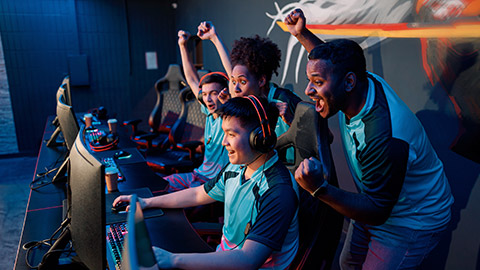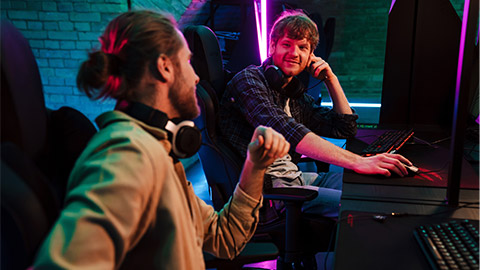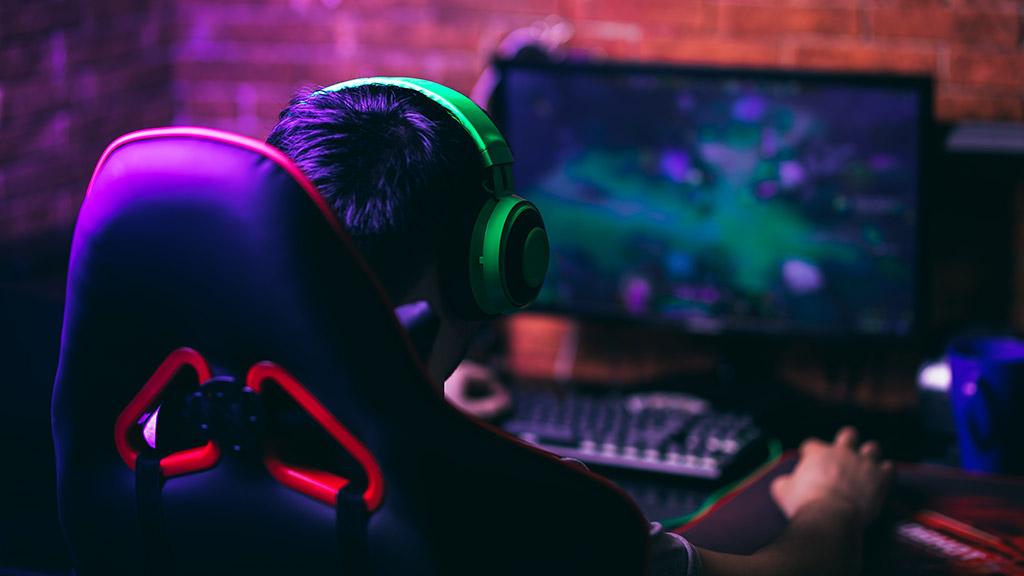eSports will rival the biggest traditional sports leagues in terms of future opportunitieseSports.com
Being a professional player is more than being excellent at the game (hard skills) — a professional player needs to build resiliencies physically and mentally.
Do you remember the differences between hard skills and soft skills? – Soft skills for an athlete are their personal skills, such as communication, coping under pressure, resilience, teamwork, and leadership. Hard skills are all about technical skills, for example, setting up shots in Valorant, combos or movement in fighting games, resource management in MOBA games or consistency with three-point shots in NBA 2K.
An athlete builds these skills in training their coach sets out but needs commitment and a growth mindset to improve further. A coach can only take the athlete so far – if the player doesn't have a will, there will not be a way.
In many role-playing games, you build a character and assign points to improve their skills in various ways. Fallout, Skyrim, Cyberpunk, Path of Exile and many more aren't only RPG games. Many sports games such as NBA 2K, WWE, Madden and even Tony Hawkes Pro Skater use skill points to build up the characters' skills and abilities.
There are plenty of resources out there which list the “top 5/10/20” for effective communication. The following is a condensed version in relation to athletes and coaches.
Attentive/active listener
A great player is engaged in what their coach says and demonstrates. This means their full attention. Active listening isn’t only giving your full attention to the speaker. It allows the listener to engage and intake important information. You are an active listener in class – as a student, you should actively listen, take notes, ask questions, and participate in the activities. Eye contact with the tutor and nodding in agreement show active listening.
When attention has been disengaged, you will notice the following body language of the audience:
- Leaning back in a chair
- Yawning
- Nodding
- Resting chin in hands
- Tapping fingers on the table
- Looking at your watch
- Gazing around the room.
Clear and concrete
Opposite of being an active listener is being an effective speaker. Project your voice outwards and towards the listener/s. This is particularly important when you are presenting or speaking to your team. Be clear with every word you say; umm’s and err’s, mumbling of words, or long awkward pauses can lose the attention of the audience. Repeatedly practice the content you are presenting. Active listeners are aware of presenters who haven’t practised.
Not only be clear with your voice, but also be clear with the message. You are trying to convince stakeholders (all of those involved, from players to technical teams) that you are spreading awareness of something important. Again, this is where practice becomes handy. Here are a few tips to follow for an amazing presentation:
- Keep the structure cohesive and logical. Make sure the audience is receiving the content in an order that makes sense.
- Work on your stage presence. An active listener is not only listening to you verbally. They are looking at your non-verbal actions, for example, body language, the way you stand, movements of your hands, eye contact, etc.
- You are allowed to breathe. Between delivery of content, take a deep breath. Ground yourself – no need to rush.
- Plan your delivery. How are you going to present the work? Do you need a visual aid to help present information in a stronger manner e.g. graphs to show data, photos for impact or text to emphasise a point?
- Understand those around you: Whether communicating with your work colleague, classmates, or team members, you must show understanding with the language, tone of voice, and message. Is it appropriate to swear? Not always, but some teams have ingrained this type of language in their culture. Your tone of voice says a lot – don’t raise your voice with mean intention if it isn’t called for. The message can include callouts in eSports and sports. Call outs the other team's location or plays you want to execute.

General eSports player skills fall mainly under these broad categories:
- Leadership
- Communication
- Teamwork
- Specific game strategies and skills
- Training style/method.
Identifying skills in eSports Athletes
Valorant
As some of you will know, Valorant is a shooter, so professional eSports players obviously need good aim. However, some players are part of the team, with that being their specialty, whereas others may bring other parts to help them excel. For example, you can see where some players excel in using the headshot stat on the website provided, as that is one of the fastest ways to kill the opposition. It is also a team game, so you must have good communication skills. With these games, there also tends to be a lot of planning, so having a strategic mind or being very knowledgeable is another skill you need. Being able to contain yourself under pressure is another skill of Valorant players, and this is easily shown using the ‘clutch’ stat, which is when the last player alive clutches out a round.
League of Legends
League of Legends is a team MOBA game largely centred around one's champion mastery and map mastery. You need to have strong micro abilities to perform on each champion and have a strong understanding of the macro to fully make use of your skills. Each role in the game will have different objectives so these player stats shown are usually based by role and region. Communication is also a majorly important skill for navigating your way through the game with your team.
No matter the sport whether physical or eSports, players will have their own strengths and weaknesses.
It is important for a coach to be aware of the common weaknesses of the team as a whole and the individuals. As the coach, it becomes part of your responsibility to foster their strengths and provide support on weaker areas for the team.
The following are examples of the strengths of eSports players.
Cognitive development
eSports can improve cognitive functions such as decision-making, strategic thinking, and players' reaction time. Playing strategy-based games requires players to think quickly and make decisions that can impact the game's outcome. Being aware of these skills and tracking when they are being utilised can later be used to transfer them to academics or the workplace.
| Strengths | Weaknesses |
|---|---|
|
|
Social connection
Participating in eSports, and being part of a team can provide children and adults with a sense of community and social connection, as they would when playing in other traditional sports. Playing with others in their school, educational institute or team can help develop communication skills, create opportunities for teamwork and collaboration, and foster positive relationships that otherwise may not be established.
| Strengths | Weaknesses |
|---|---|
|
|
Physical
eSports can also promote physical activity and healthy habits. There are games that involve physical movements like "Just Dance", which is part of the Olympics eSports Week list of games. There are purpose-built gaming accessories can help develop coordination and motor skills.
| Strengths | Weaknesses |
|---|---|
|
|
Developers and publishers have incorporated leaderboards and point systems for exercise and physical activity in some games.
Mental health
Engaging in eSports can give children and adults a sense of accomplishment, boosting their self-esteem and confidence. It can also serve as a healthy coping mechanism for stress and anxiety as they emerge in the game; it can help them unwind - particularly if the game is leisurely, not used for competition. However, when goals and achievement targets have been added, whether in gameplay or personalised, the individual can add an extra sense of achievement, and if they fail, they can learn and try again without it creating a negative experience.
| Strengths | Weankesses |
|---|---|
|
|
Watch: Anecdote 2 (2:35 minutes)
Career opportunities
eSports can offer career opportunities in various fields, including:
- Gaming
- Broadcasting
- Production
- Event management
- Content creation.
(GEES, n.d.)
| Sports | Entertainment | Business |
|---|---|---|
|
|
|
The industry also includes many of the traditional roles related to legal, business, coaching, and so on.
Knowledge Check Activity
Case study
For a while there has been a hot debate in League of Legends Champions Korea … who is the best League of Legends player? Is it Faker or is it Chovy? Is it the proven world champion or the gifted new talent?
Faker:
Team captain of T1, Mid Laner and former 3-time world champion, Faker sits in a comfortable position having proven his consistency, communication and experience while not leaving behind his mechanics and game knowledge. Even though T1s has been qualifying to Worlds, the team's performances have fallen short in international competition, leaving them out on the last stages of the Worlds Championships and denying the crown for the former League of Legends king. Some believe that Faker is out of his prime and the team should be making moves to find his replacement.
Chovy:
The current Mid Laner for former world champion org Gen G. Being the most mechanically gifted player in Korea with a bright future, Chovy has won several domestic titles but has never seen a world championship title.
Even though no one could match him on a 1 vs 1, Chovy's bright future has not delivered internationally. Some speculate that this must be because of his inexperience performing against other high-calibre players that match his skills or even the allegations of him being stage shy.
Learning Activity Forum
Use the case study, and for both Faker and Chovy, identify three:
- skills
- strengths
- weaknesses.
Discuss your findings with your peers on the Learning Activity Forum.
Strong communication skills are necessary in all occupations such as an animator, graphic designer, duty manager, front-of-house staff, chef, administrator, and many, many more. Communication is an interpersonal skill (soft skill). Interpersonal skills include interaction and communication (verbal and non-verbal) between people. This will be explored in more detail in our next topic.

Communicating a message effectively is a very important skill, particularly within eSports and being part of a team. It is important to note that communication must be two-way between a sender and a receiver for communication to be as effective as possible.
Why do we communicate?
To connect emotionally and socially, develop relationships, give instructions, to inform, express feelings and opinions, ask questions, express wants and needs, achieve a task, to persuade, share and exchange ideas, safety, and survival, to understand each other, show our identity, be part of society.
What channels and methods can a sender and receiver use?
Four methods of communication
- Verbal: speech, language type, language style, noises, song
- Non-verbal: body posture, gestures, facial expressions, sign language, music
- Written: essay, books, text, email, print media
- Visual: art, symbols, graphics, colour, design, photographs.
Sender and receiver
The sender, as the name suggests, is the person who is delivering the message, and the receiver is the one listening or receiving the message.
Sender factors
The following are factors the sender might consider when deciding on a channel or method for their message.
Can the receiver
- Use technology
- Use sight
- Hear
- Understand
- Speak the languages?
Appropriate for the context
The sender must consider what language should be used for the situation or context, formal or informal, the time it takes for the message to be transmitted and responded to.
Message received
The sender must be able to 'read' or determine whether the receiver has taken the message as intended. The sender should look for body language to signal understanding/hearing, from the response to the message, ask the receiver to repeat it back, ask a question to check understanding and listen for feedback.
Barriers
The sender must consider the possibility of barriers when sending their message. The sender may need to consider the following barriers.
- Translating the message into an unfamiliar language.
- The receiver is not focusing.
- Noise causing interference with the message either being heard or received/technology breakdown. This is common when communicating on the phone or via computer platforms (Teams, Zoom, Skype, etc.).
- The message being misinterpreted and the possibility of not being aware message has been misinterpreted.
- Cultural/language/social differences between both the sender and receiver geographical location.
- Difficulty encoding thoughts into a message.
- finding the right words to express the idea.
- Expressing emotion.
- Time constraints.
- physical and mental abilities.
Receiver Barriers
The sender is not the only one who may experience barriers. The receiver may also encounter their own barriers. Including:
- Boredom
- Preoccupation with own:
- thoughts and ideas on the topic or on something else.
- High levels of:
- emotion
- anxiety.
- Busy formulating their own reply.
Communicating effectively
The following are factors to consider when sending a message to others.
- Thinking before sending.
- Determining the receiver's understanding of the subject or situation.
- Choosing the correct channel for the situation.
- Awareness and adaption to cultural differences.
- Give the full message/explain it well so the receiver understands.
- Show respect for the receiver.
- Correct spelling and grammar so the message is clear in written communication.
Role of the Receiver
Part of the role of the receiver of verbal messages is to be an active listener.
The sender should always ask if the receiver has understood and should paraphrase and summarise the information.
Knowledge Check Activity
